This week’s Listed section ventures out from the Old World to look at Argentina’s top five brands. Wine Lister’s Brand score measures a wine’s performance across two criteria – restaurant presence and online popularity. The five Argentine wines, from three producers, all achieve scores that are either strong or very strong on Wine Lister’s scale, indicating that South America’s strongest brands are now established on the global fine wine market.
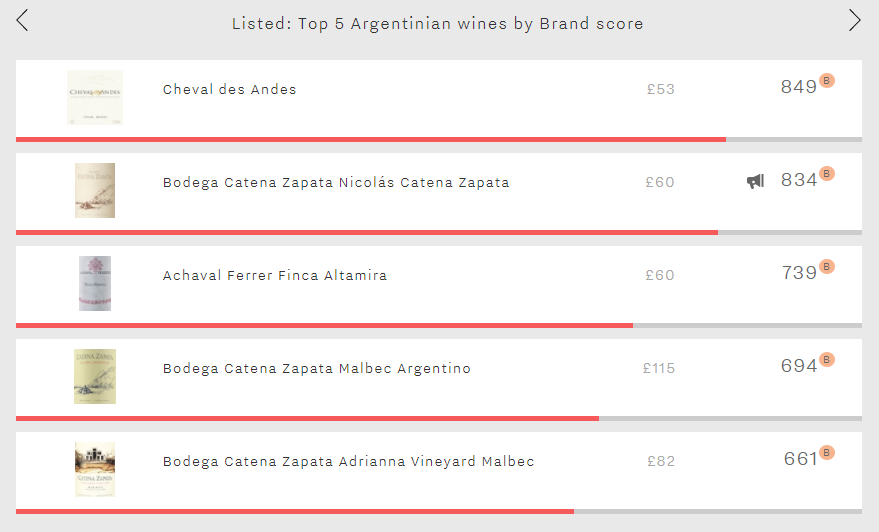
With a Brand score of 849, Argentina’s leading icon is Cheval des Andes. A joint venture between Saint-Emilion heavyweight Cheval Blanc and Terrazas de los Andes, it leads the way when it comes to restaurant presence, featuring on 14% of the world’s top wine lists – its closest rival in that criterion, Bodega Catena Zapata Nicolás Catena Zapata appears on 9% of the same lists.
Nicolás Catena Zapata (834) turns the tables in terms of online popularity. The only Buzz Brand of the group, it receives on average 2,349 searches each month on Wine-Searcher, 27% more than Cheval des Andes (1,853). It also achieves the greatest vertical restaurant presence of the group, with 2.7 listings on average per list.
Nearly 100 points behind is third-placed Achaval Ferrer Finca Altamira with a score of 739. Appearing in 7% of restaurants and receiving 999 searches each month, it achieves its best score in the Brand category, comfortably outperforming its Quality score (581) and Economics score (183).
The last two spots are filled by two more wines from Bodega Catena Zapata – Malbec Argentino in fourth place (694) and Adrianna Vineyard Malbec in fifth place (661). Both receive a similar number of searches each month (744 and 793 respectively), and are visible in 6% and 4% of restaurants respectively.
For the second consecutive quarter, the five wines which saw trading volumes rise most were all from Bordeaux. Four of the wines below are big hitters, with overall Wine Lister scores ranging from 921 (Château Montrose) to 963 (Château Lafite Rothschild).
These top crus are also mainstays at global fine wine auctions, with over 2,000 bottles of the top five traded vintages of each wine selling at auction every year, and over 5,000 for Lafite. So, while auction trading volumes – a measure of liquidity – feed into a wine’s Economics score, none of the four has seen a significant enough increase to find their Economics score significantly changed.
There is one anomaly. Château Larrivet Haut-Brion has an average price of £23 per bottle, and from the period of July 2016 until June 2017 its top five vintages sold only 103 bottles at auction. At the end of last month, however, 228 bottles of the wine’s 2000 vintage were sold at a Bonham’s auction, making the wine the most popular of the day. The update to Larrivet Haut-Brion’s trading volumes has had a strong impact on its Economics score, which has risen from 567 to 667, and boosted its overall Wine Lister score from 663 to 684.
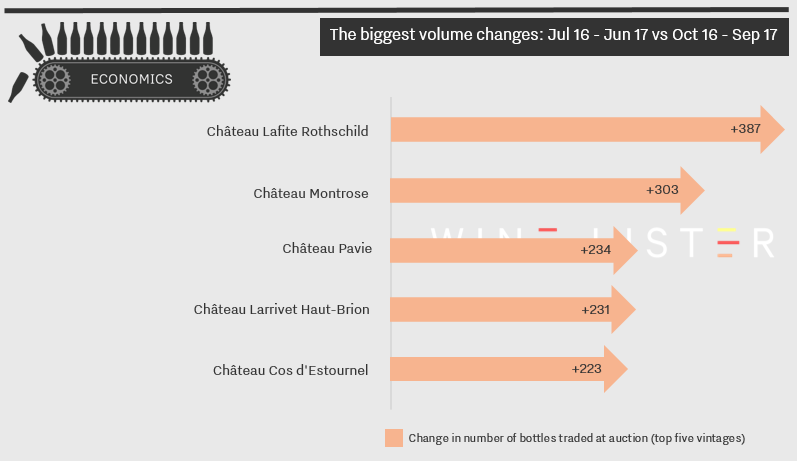
We calculate which wines have seen the greatest incremental increases in bottles traded by using figures collated by Wine Market Journal from sales at the world’s major auction houses.
Wine Lister’s holistic, dynamic rating system tracks a wine’s performance over time. By constantly analysing a wine’s brand strength and economic performance, as well as updating its Quality score as it is retasted by our partner critics, Wine Lister’s ratings evolve over time, as demonstrated by our new score history tool.
Wine Lister’s Economics score is a perfect case in point. Reacting to the very latest market data, it analyses a wine’s performance across several criteria: three-month average bottle price; short and long-term price performance; price stability; and liquidity. A strong showing across these criteria is what defines the five wines in this week’s Listed section – Bonnes-Mares’ top wines by Economics score.
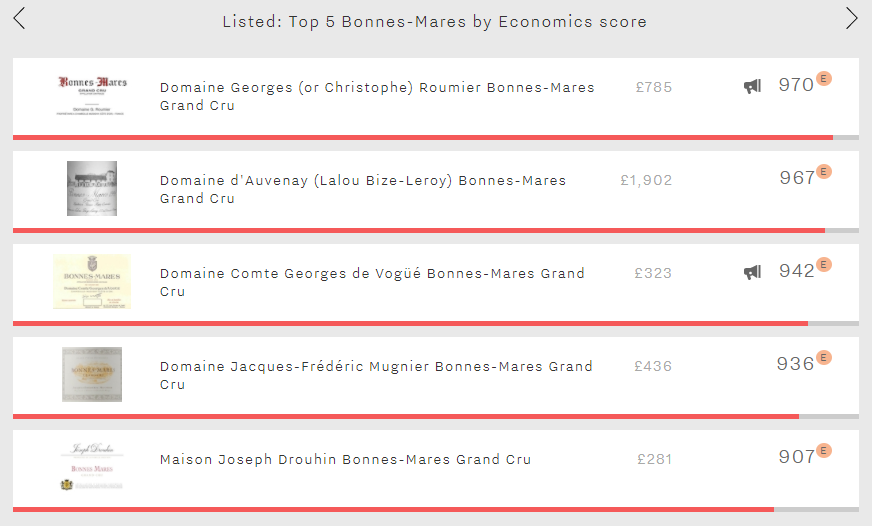
Whilst all five achieve Economics scores that put them amongst the very strongest on Wine Lister, it is Domaine Georges Roumier’s Bonnes-Mares that leads the way with an outstanding score of 970. It is the most liquid of the five, its five top-selling vintages having traded 414 bottles over the past four quarters.
In second-place is Domaine d’Auvenay’s Bonnes-Mares (967). Underlining the Queen of Burgundy’s continuing surge in demand, it has a remarkable three-year CAGR of 35.6% (nearly double that of Domaine Jacques-Frédéric Mugnier’s Bonnes-Mares, its closest rival in that criterion). Its price is the highest of the group by a considerable distance, at £1,902.
Domaine Comte Georges de Vögué fills the third spot with its Bonnes-Mares’ Economics score of 942. One of the group’s two Buzz Brands, it is the second most-traded of the five (327 bottles), and has strong short-term price performance, its price having increased 11.2% over the past six months.
The Bonnes-Mares from Domaine Jacques-Frédéric Mugnier and Maison Joseph Drouhin fill the last two spots. Whilst they display similarly modest levels of liquidity (having traded 63 and 68 bottles over the past four quarters respectively), Mugnier leads Drouhin thanks to its considerably higher price (£436 vs £281) and superior long-term price performance (three-year CAGR of 18.2% vs 13.9%).
And thanks to Wine Lister’s approach, these scores will continue to change over time, meaning that they are always relevant and reflect the wine’s evolving position in the market.
We are thrilled to announce the addition of Jeannie Cho Lee MW as Wine Lister’s fourth partner critic, representing the Asian market.
Wine Lister gathers data from multiple sources to assess thousands of wines on a truly holistic basis. Scores are made up of three main categories: Quality, Brand, and Economics. Critic ratings form a vital part of the Quality category, providing reliable scores and drinking window information.
Jeannie Cho Lee is an independent wine critic, a university professor, and an award-winning author who in 2008 was the first Asian to become a Master of Wine. Based in Hong Kong, she writes about wine on her website, www.jeanniecholee.com, and has also published several books, including Asian Palate.
Adding to our unique collaborations with three of the most reputable wine critics in the world’s major fine wine markets – Jancis Robinson (UK), Antonio Galloni (Vinous) (USA), and Bettane+Desseauve (France) – we are delighted to welcome Jeannie Cho Lee to represent the key Asian fine wine market. This careful addition will help us in our goal of providing ever more reliable and accurate ratings and analysis, while crucially maintaining the high standards of this elite pool of critics. Jeannie Cho Lee’s scores have been added to those of our existing partner critics, and fed into Wine Lister’s bespoke algorithm to produce a Quality score out of 1,000 points. Wine Lister takes each critic’s minimum and maximum wine ratings and spreads these back out over the entire scale. As each wine critic scores differently (not just on a different scale), we also account for the frequency of ratings and normalise scores for fair comparison. Each critic is weighted equally.
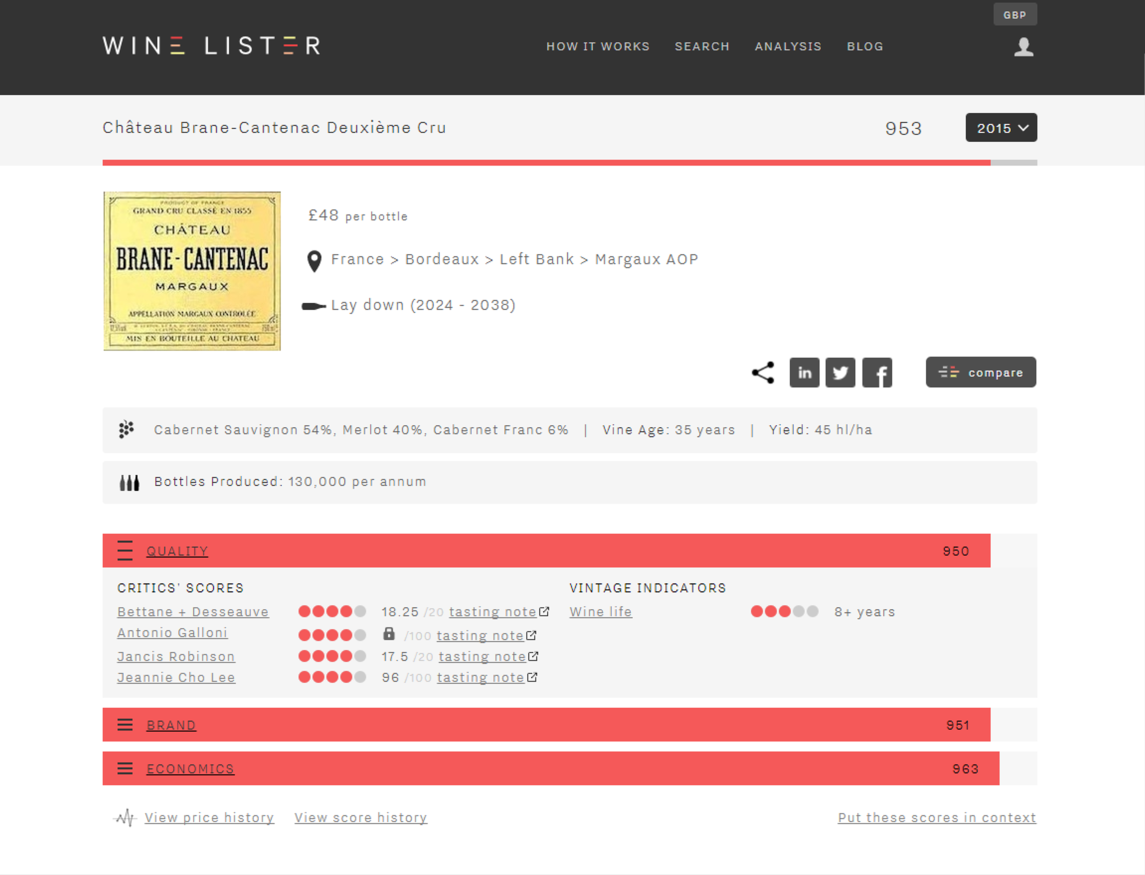
You may notice that some scores have changed for wines that have not been rated by Jeannie. In order to meet our goal of having the most comprehensive and up-to-date information, and the most rigorous rating algorithm, we have increased the sample set of scores upon which we carry out the normalisation between critics. This now includes the 18 months’ worth of new critic scores since our launch.
Having ushered in Autumn with some of Northern Italy’s foremost brands, our Listed section continues its whirlwind tour of the world’s great wine regions in the Rhône. Home to some of France’s most illustrious producers, the Rhône tends to garner the most attention for its reds. However, its whites are well worth a mention too, and don’t require quite the same budget. Here we look at the region’s five most expensive dry whites.
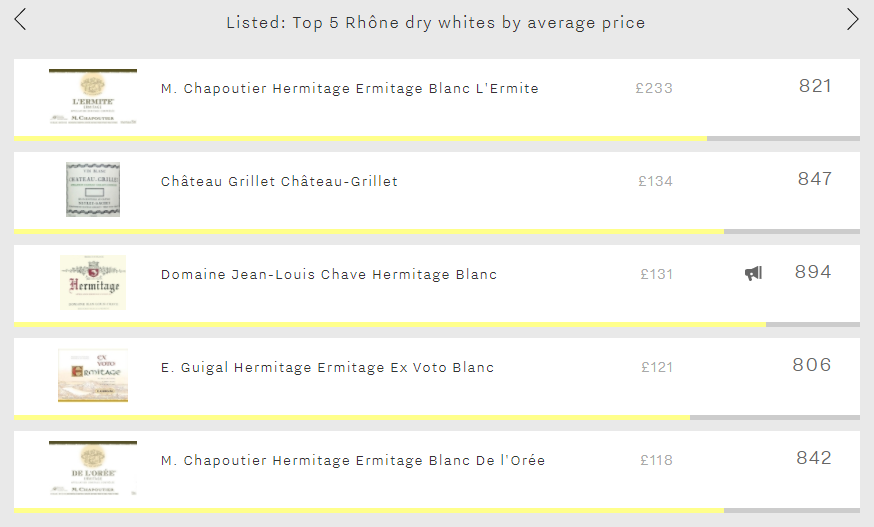
Interestingly, all five wines are from the Northern Rhône, with Hermitage home to four of them. M. Chapoutier Ermitage Blanc L’Ermite tops the table. The first of two wines from Michel Chapoutier, at £233 per bottle it is by far the most expensive of the five. It also outperforms the others in the Quality category – with an outstanding average score of 961.
Château Grillet is the only wine of the five not produced in Hermitage. This 100% Viognier from the eponymous monopole (one of only a handful of single-estate appellations in France – can you name the others?) commands an average price of £134. It enjoys by far the best Economics score of the group (824), thanks to exceptional short-term price performance – its price having risen 22% over the past six months.
Snapping at its heels is similarly priced Domaine Jean-Louis Chave Hermitage Blanc. It achieves an average Quality score of 954, just six points behind that of its red counterpart. It is also the only Buzz Brand in the group, and enjoys the best Brand score (918).
Around the £120 mark, E. Guigal Ermitage Ex Voto Blanc and M. Chapoutier Ermitage Blanc De l’Orée fill the fourth and fifth spots. Underlining the outstanding quality of the group, they both achieve scores of over 900 in the category, ranking them amongst the very strongest on Wine Lister.
If we compare the quality to price ratio of these five whites and the Rhône’s five most expensive red wines, the whites look good value. Whilst the reds achieve a slightly better average Quality score (957 vs 919), you pay a significant premium for them – their average price is over 4.5 times higher than that of the whites (£671 vs £147).
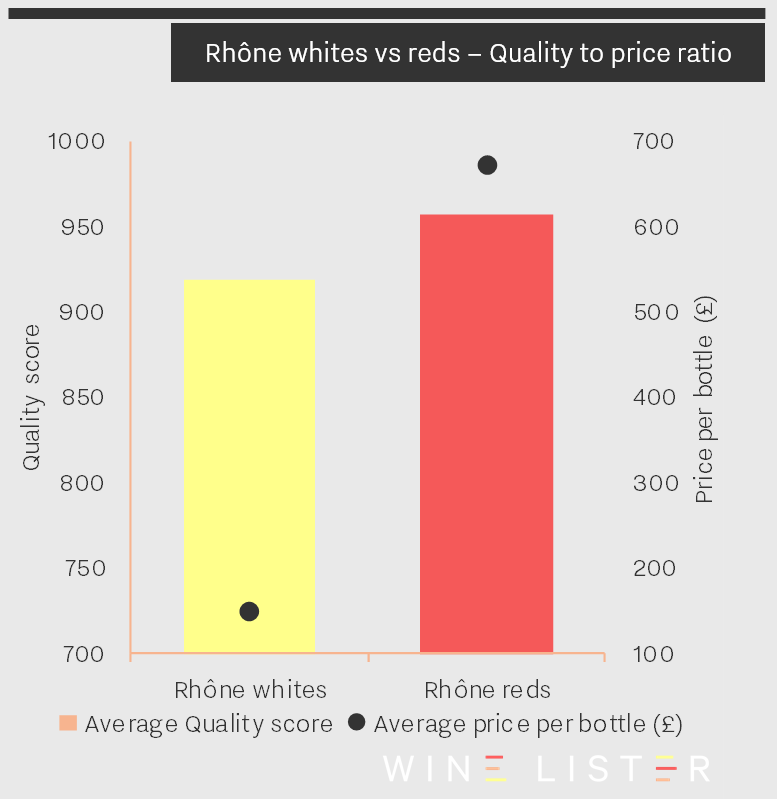
The annual spate of releases in September has influenced this month’s gainers in online search frequency. For the third consecutive month, Dom Pérignon Vintage Brut has seen the largest increase in average monthly searches, which we calculate using three-month data from Wine-Searcher measured against the previous period. Dom Pérignon 2009 was released in early September, and the wine’s increase of 5,154 searches is the largest incremental monthly increase seen this year, taking it to 60,241 average searches per month: the highest of any Champagne and fifth highest of all wines.
Following last month’s narrowing of regions within the top five (only two were featured), the breadth in September significantly increased, with icons from California, Bordeaux, Piedmont, and Chile joining Champagne. The number of searches has also increased dramatically after the summer slowdown, with 19 wines seeing an increase of over 1,000 average monthly searches. The release of Opus One 2014 at the beginning of September – judged “a gorgeous wine” by our partner critic Antonio Galloni – has boosted interest in this Napa Valley stalwart, with an increase of 4,651 searches taking it to over 40,000 searches per month.
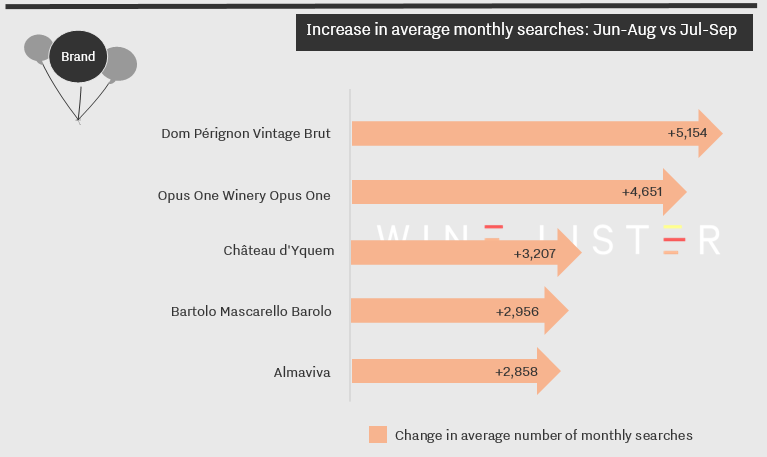
Château d’Yquem is another wine to see online search frequency rise on the back of a September release. The 2015 was released alongside Opus One 2014 at €250 ex-négociant.
The next in the table, Bartolo Mascarello Barolo, has the lowest search frequency of any of the wines above, with an average 10,075 per month. Nevertheless, with an overall Wine Lister score of 941/1,000 the wine is one of the great names of Barolo: the fourth best overall on Wine Lister.
Almaviva celebrated its twentieth anniversary in June, while its producer Viña Concha y Toro has recently entered the global ranking inside the Top 10 Beverages category within the Dow Jones Sustainability Index for the first time. With the release of Almaviva 2015 in early September adding to the interest, the wine has seen an increase of 2,858 online monthly searches, taking it to 11,291.
With the days quickly shortening and misty mornings become the norm, we bid farewell to rosé for the year and welcome back old favourites. Autumn is the perfect season for Piedmontese reds, which are not only so redolent of mist-covered hills, but also pair perfectly with the region’s food at this time of year. With that in mind, this week’s Listed section features Piedmont’s top five wines by Brand score.
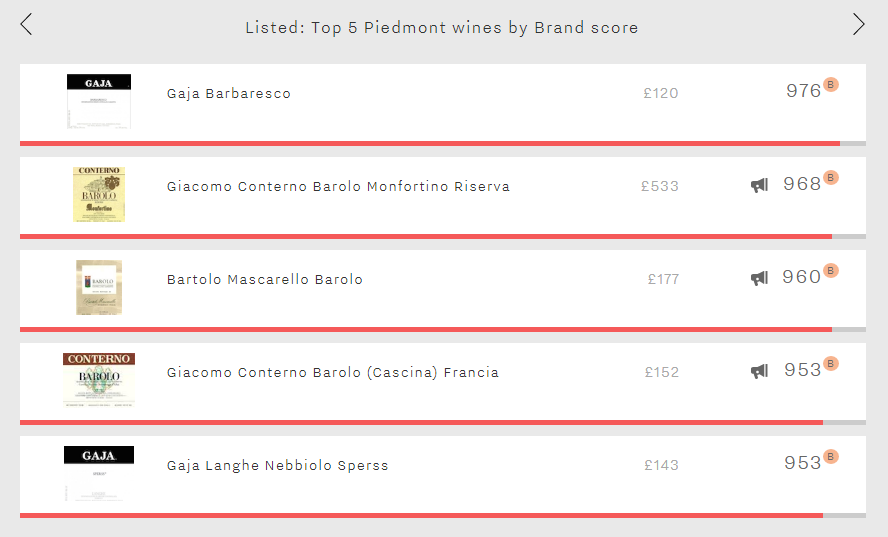
Whilst Barolo might be the region’s most famous appellation, it is Gaja Barbaresco that tops the table with an outstanding Brand score of 976. It performs extremely well across both of Wine Lister’s Brand criteria – restaurant presence and online popularity – coming first and second respectively. It is visible in 33% of the most prestigious establishments worldwide, and attracts more than 8,400 searches on Wine-Searcher each month.
Giacomo Conterno Barolo Monfortino Riserva comes next (968). The first of three Wine Lister Buzz Brands in the group, it is by far the most expensive. Receiving on average 9,358 searches each month on Wine-Searcher, it is also the most popular wine in the group. Interestingly, despite experiencing the lowest restaurant presence (23%), it enjoys the greatest depth in terms of number of vintages and formats listed (4.4) – testament to its extraordinary ageing potential of over 24 years.
Bartolo Mascarello Barolo (of “no barrique, no Berlusconi” fame) fills the third spot. This staunchly traditional producer enjoys its best scores in the Brand category, with its excellent search frequency of over 7,000 searches each month helping it to a score of 960.
The last two spots are filled by another wine each from Giacomo Conterno and Gaja – Barolo Francia (formerly Casina Francia) and Sperss (now labelled as Barolo again from the 2013 vintage after 17 years declassified to Langhe Nebbiolo) [Friday fun fact – Gaja now labels wines under the Europe-wide DOP classification rather than the strictly Italian DOC status]. Both wines have strong restaurant presence, at 30% and 31% respectively. Either would be a perfect accompaniment to Alba’s famous white truffles, which will be starting to appear in some of those restaurants now.
Analysis of Pol Roger Cuvée Sir Winston Churchill 2006, which has been released today in the UK at £100 per bottle, with a Wine Lister Quality score of 983 – its best ever:
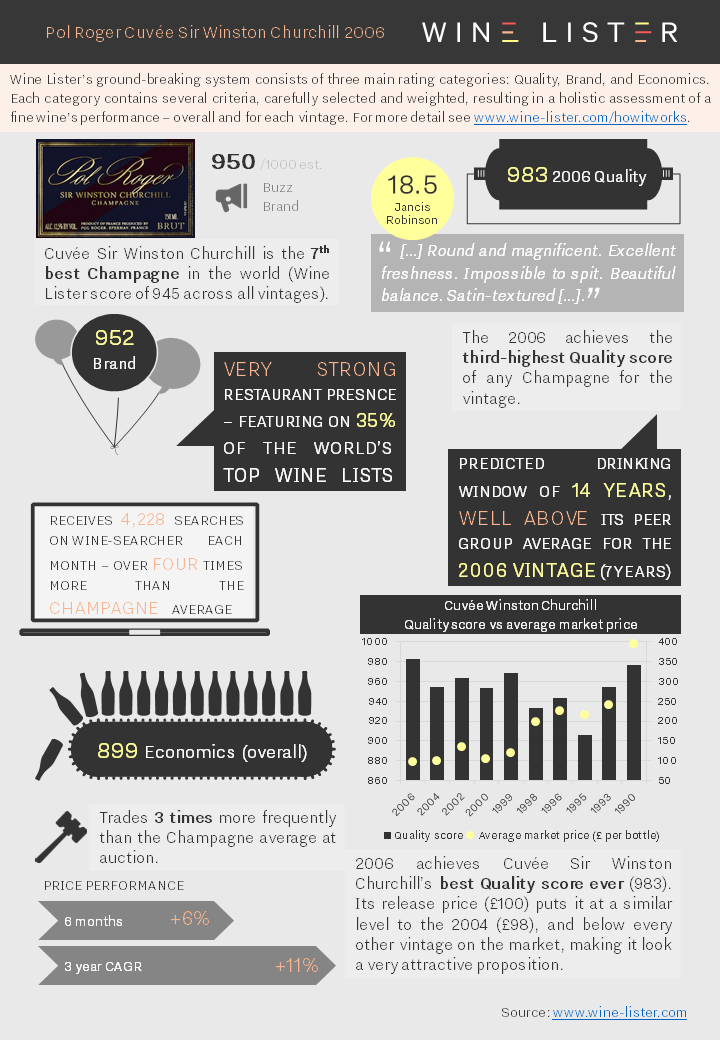
You can download the slide here: Wine Lister Fact Sheet Pol Roger Cuvée Sir Winston Churchill 2006
Wine Lister’s Brand category measures a wine’s performance across two criteria: popularity and distribution. In conjunction with its Quality and Economic performance, this allows a holistic assessment of a fine wine. It also enables a comparison of the performance of entire fine wine regions. Below we look at the average scores over both Brand criteria of the top 50 wines in Bordeaux, Burgundy, California, Italy, and the USA.
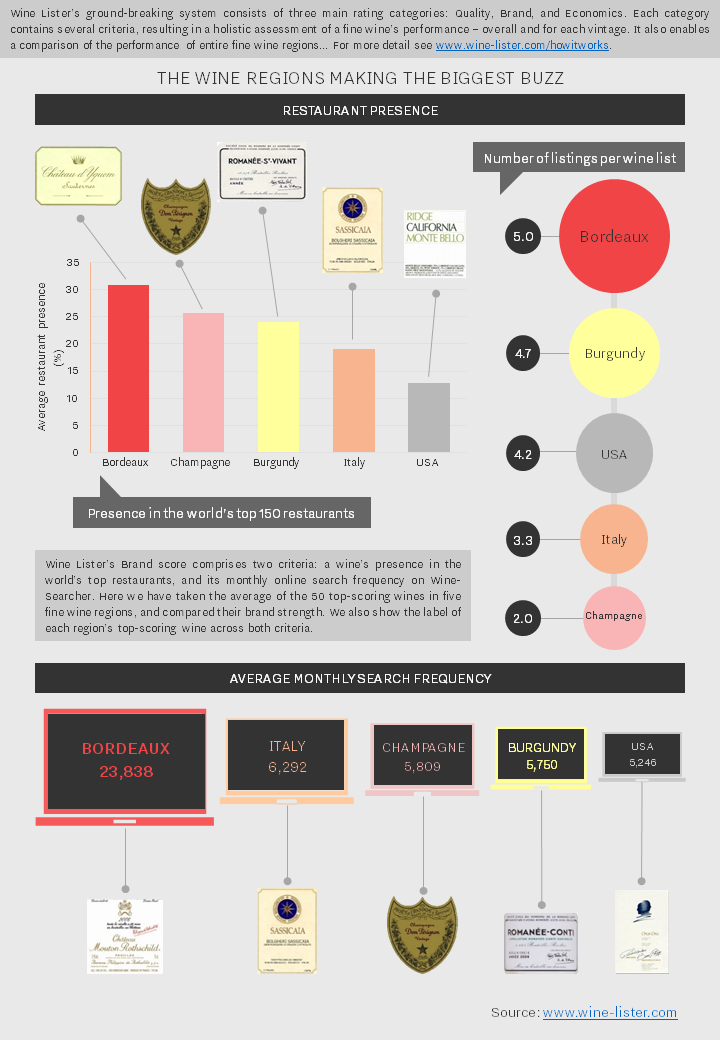
Bordeaux dominates, with powerhouses Yquem and Mouton demonstrating the success of its classification system and the centuries-old global repute of its top crus. Its best wines are by far the most popular with consumers – searched for nearly four times more frequently on average than second-placed Italy. They are also the best distributed in the world’s most prestigious restaurants, present in 31% on average, and with 5 references per list.
Whilst Champagne comes second in terms of breadth of presence in restaurants, its top wines don’t achieve much depth in terms of vintages or formats listed – presumably because many of them are non-vintage.
Burgundy competes well in terms of restaurant presence, with the likes of Domaine de la Romanée-Conti Romanée-Saint-Vivant Grand Cru enjoying a strong showing in top restaurants. Meanwhile the region is fourth most popular in terms of searches each month on Wine-Searcher.
Italy is unique in that Sassicaia is both its most popular wine and also its best distributed. However, whilst its top wines are the second most popular overall, they also experience the second lowest level of distribution.
Finally, the USA’s best wines achieve a strong level of vertical restaurant presence, but come last in terms of both horizontal presence and popularity, suggesting the New World still has a way to go in terms of brand strength.
Download a PDF version here.
First published in French in En Magnum.
In an attempt to squeeze every last drop out of summer, this week’s Listed section features Wine Lister’s top 5 rosés by Quality score. Whilst the Côte d’Azur might seem a long way away, these five Provençal wines serve as a reminder of warmer climes and long sunny days.
Wine Lister’s Quality score measures a wine’s performance across two criteria – critics’ scores and ageing potential. Whilst these wines perform relatively well with the critics, they are not built with longevity in mind, and have an average predicted drinking window of just three years – compared to 17 and 16 years respectively for the top five whites and reds for Quality.
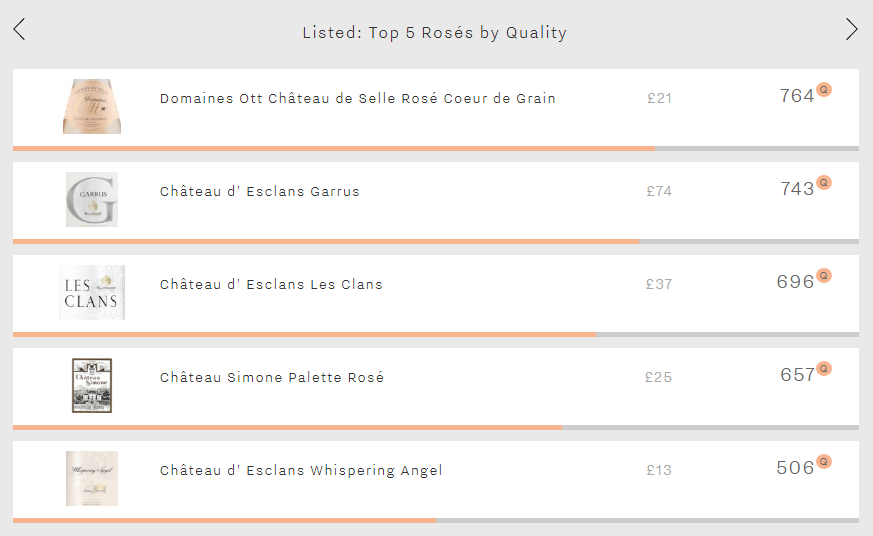
Domaines Ott Château de Selle Rosé Coeur de Grain tops the table with a very strong Quality score of 764. Currently priced at around £21 per bottle (depending on the retailer), it is the second-cheapest of the five, and represents excellent value for money.
Garrus, the first of three wines from Château d’Esclans, comes next with a Quality score of 743. At £74 it is by far the most expensive of the group – over twice as expensive as is its close relative Les Clans, with a Quality score of 696. Both these wines divide the critics, performing well with Antonio Galloni and Jancis Robinson, but less favoured by Bettane+Desseauve.
In fact, the French duo are considerably less enamoured with these five rosés than Jancis Robinson in general. Perhaps still rosé has a way to go before it is considered a serious vinous offering in France.
Château Simone Palette Rosé fills the fourth spot with a score of 657, followed by a third wine from Château d’ Esclans – Whispering Angel. Whilst it has a modest Quality score of 506, and is by far the least expensive of the group, it has by far the best Brand score (805). Proof that formidable branding can propel a wine beyond where its intrinsic quality level might suggest (though we certainly wouldn’t turn our noses up at a chilled glass of Whispering Angel on a sunny day like today).










